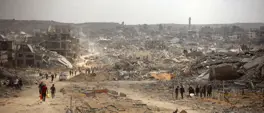MALAIKA MAHLATSI: Rand Water - How bad politics in municipalities overshadow good stories
Malaika Mahlatsi
2 September 2024 | 8:15Many South Africans do not understand how government actually works, and so, when the water from their taps comes out filled with sediment, as was the case in Hammanskraal, the conclusion is that the fault lies with water boards. This could not be further from the truth, writes Malaika Mahlatsi.
Between 2022 and 2023, as part of my academic work at the Institute for Water Research at Rhodes University, I undertook research in Hammanskraal, a township in the City of Tshwane metropolitan municipality.
The aim of this research, which culminated in my Masters in Water Resource Science degree, was to study the equity dimensions and governance drivers of water security challenges in South Africa’s administrative capital.
While the City of Tshwane in general, and Hammanskraal in particular, has been faced with water challenges for over a decade, the situation has worsened significantly over the past eight years.
Last year, Hammanskraal became the epicentre of a devastating cholera outbreak that claimed many lives. Months into the outbreak, the national Department of Water and Sanitation commissioned the Water Research Commission (WRC) to undertake an independent investigation into the cause of the outbreak.
In July 2023, the findings of the independent investigation concluded that the source of the outbreak was unknown. More than a year later, we are no closer to knowing the truth about an outbreak that caused immeasurable suffering.
Nonetheless, we can deduce that the state of the water infrastructure in the City of Tshwane, and specifically the Rooiwal Wastewater Treatment Plant in Temba, played a significant role in the outbreak.
This conclusion is drawn from the extensive research that outlines how poor water governance in the administrative capital led to the deterioration of the said wastewater treatment plant over the years.
The matter was brought before the South African Human Rights Commission, which, just a few years before the cholera outbreak, declared the water in Hammanskraal unsafe to use, and accused the municipality of violating human rights owing to water being deemed a fundamental right – one that is enshrined in the Constitution.
There is no question that South Africa is facing a serious water security challenge – one resulting from physical scarcity due to the country being semi-arid, as well as poor governance, particularly by municipalities.
Water researchers such as myself have argued that the most important intervention that should be made is the development and maintenance of water infrastructure. One institution that is playing its part in this regard is Rand Water.
A week ago, while doing research on the impact of migration on public services and infrastructure in South Africa, I decided to read Rand Water’s integrated annual report for the year 2023.
With 324 pages, the report is comprehensive, providing in-depth analysis of the state of water in the country as well as some of the challenges that the water entity is confronted with. I was especially interested in finding out what interventions Rand Water is making to address the water infrastructure challenges in the country in general, but Johannesburg in particular.
This is because Johannesburg, as the nerve-centre of the provincial and national economy, is the largest city in South Africa, with a population in excess of five million. Johannesburg is also home to the majority of migrants from the Southern Africa Development Community (SADC) region and the world. Thus, sustaining its burgeoning population requires forward thinking in resource planning, particularly for water.
Over the past few years, Rand Water has been investing in massive infrastructure development, culminating in the launching of the 210 megalitres Vlakfontein Reservoir in Germiston, City of Ekurhuleni. This brings the total number of reservoirs owned by the entity to 59.
Reservoirs are an important component of water infrastructure, particularly in water-stressed countries like South Africa. This is because reservoir water can be used to supply water to our homes, and more importantly, to factories.
Reservoirs are designed to store the rain that falls during the wetter parts of the year, so that there is a continuous supply of water for the drier periods. For a province like Gauteng that serves as the manufacturing nerve-centre of the region, the availability of water is especially important.
It is not possible to grow our country’s manufacturing capacity without investing significantly in resources such as water and electricity. Thus, Rand Water’s investment in building reservoirs to store and conserve our limited water is a crucial intervention.
Upon completion of reading Rand Water’s integrated annual report, I had a conversation with a friend about the great work that the water board is doing.
I was surprised when she argued that Rand Water is failing the people of Gauteng who rely on it to provide water, because I immediately understood that, like many South Africans, she does not understand the role of the entity or the water purification process in our country.
Water that is stored in reservoirs is not what we receive in our households. It needs to be purified before it can be utilised. The role of ensuring that purified water reaches our taps is not that of Rand Water, but of municipalities.
The entity’s primary responsibility, as defined in law, is to provide water services (bulk and reticulation) to other water services institution such as municipalities.
To simplify this, Rand Water sells water to municipalities, who are then required to ensure that it undergoes a series of water treatment steps that include coagulation, flocculation, sedimentation, filtration, and disinfection. These steps happen in wastewater treatment and water treatment plants such as the Rooival Wastewater Treatment Plant in Hammanskraal.
Municipalities, not Rand Water, are responsible for these plants and for ultimately ensuring that clean water reaches our homes and industries.
As an entity, Rand Water’s performance is very good. In terms of its operational performance, it has consistently surpassed its SANS 241 Composite Indicator on the quality of water. In 2023, it achieved 99.35% in this regard.
It also did well in other areas, including overall project completion, reduction of water losses, and contribution to socio-economic development.
Its financial performance has also been exceptional. Among other things, its gross profit has been increasing sustainably for the past five years. Furthermore, the entity’s funding position, at 12%, is well below the threshold of 50% as prescribed in the National Treasury Borrowing Limit Approval.
The fact that it has achieved clean consecutive audits over the past few years is evidence of its efficiency and good governance practices. But few people know this because the entity’s good work is overshadowed by the failures of municipalities.
The story of Rand Water is a story of how poor governance and maladministration in municipalities makes entities that are performing well appear dysfunctional in the eyes of the public.
Many South Africans do not understand how government actually works, and so, when the water from their taps comes out filled with sediment, as was the case in Hammanskraal, the conclusion is that the fault lies with water boards.
This is especially the case in Gauteng, a province that is battling with severe water issues. Rand Water, being one of the largest water boards in the country and servicing a significant part of Gauteng, often shoulders the blame for the incompetence of municipalities.
In addition to this unfair burden, the entity is also a casualty of the poor financial state of municipalities as illustrated in the audit outcomes published by the Auditor General a week ago, which revealed that only 34 of the country’s 257 municipalities received clean audit outcomes.
Rand Water has experienced deterioration of its financial health due to non-payment of debt by its customers, mainly municipalities. As at end of the 2022/23 financial year, the collective overdue debt owed by municipalities is over R4 billion.
Such a debt burden affects not only its cashflow, but its ability to build more water infrastructure.
And therein lies one of the many problems with a poorly run municipalities – they overshadow the good work of other organisations.
Malaika Mahlatsi is a geographer and researcher at the Institute for Pan African Thought and Conversation. She is a PhD in Geography candidate at the University of Bayreuth.
Get the whole picture 💡
Take a look at the topic timeline for all related articles.
Trending News
More in Opinion

14 October 2025 14:34
CHARLES MATSEKE | How the Madlanga Commission became a Chessboard for power

14 October 2025 12:05
JAMIL F. KHAN | A ceasefire without freedom: How Israel’s ‘peace plan’ tightens its grip on Palestine

10 October 2025 17:39
MALAIKA MAHLATSI | The rise of political celebrities and the appeal of the lowest common denominator












